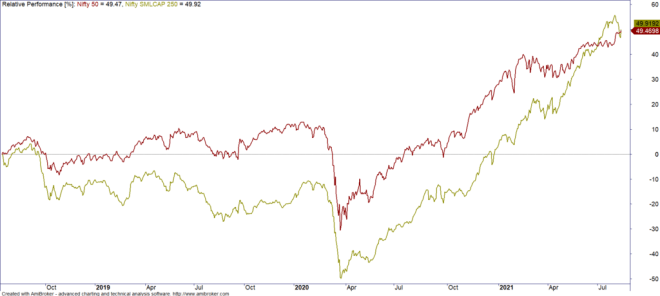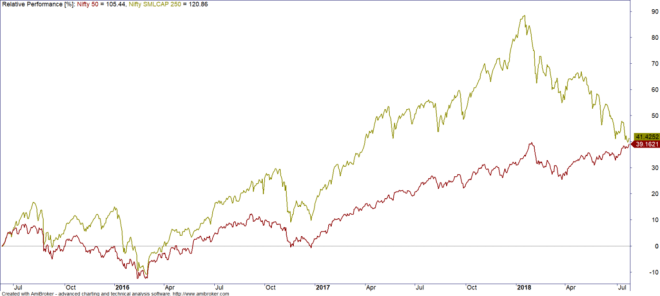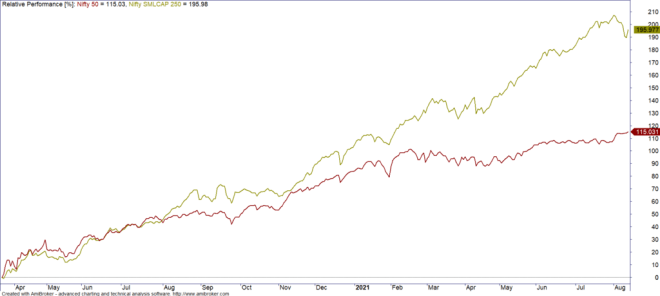The following is part of a note written to subscribers. Sharing the same here
It would not be an understatement to say this week was a tumultuous one for mid and small cap portfolios. While a small correction is not really something one should be worried about, the fact that the correction is coming after months of rise should make us pause and take a deeper look.
As I wrote in the Monthly Newsletter last week, our performance has been inline with the performance of the small-cap universe since the start of this rally in April 2020. Since the low in March 2020, Nifty Small Cap 250 has delivered a return of around 200% vs returns of 110% for the large cap universe.
This outperformance came with barely there volatility. But if history is any guide, this is going to change.
One of the philosophies followed by Technical Analysts is Elliott Wave Analysis. This theory posits that markets move about in waves. Bull markets are divided into 5 waves while bear markets are divided into 3.
The theory has its faults but in the broader sense it actually showcases how Fear and Greed combined with economic cycles are seen in markets. While pure ellioticians use the strategy to try and predict to a precise level where the index shall go, I use it to get an understanding of where we are in a cycle and how the future could unfold.
The Wave 1 of a new cycle is always sharp, mostly surprising and one that sees investors mostly itching to get out versus getting in. If we were to take the move from the lows of March 2020 to today, it fulfills the first couple of requirements. The strong move up was a surprise to the best of the analysts tracking the markets.
Let’s look at what to me are a couple of Wave 1 in action in the past. Do note that these may not match the purists who are more detailed, but my objective here is not to try and find where the markets shall end at but provide a context to the move and what we can expect in the forthcoming weeks / months.
The bust of the Dot Com bubble brought Nifty down 55% from the peak. While the Vaypayee led NDA government was in power, for the markets, it may well have been the Deve Gowda period – a period of absolute lacklusterness and low activity.
Starting in May 2003, the markets took off in a way that was reminiscent of the dot com bubble but was more broader than the previous avatar. From the low of 920, Nifty went up to cross the 2000 mark before the correction started.
The correction in itself was deep owing to the surprise fall of the NDA government with Nifty at the worst point being down 36% from the highs. The move up in the Indian markets wasn’t really independent. The S&P 500 Index too started to move from Mid March 2003 before topping out in February 2004.
While the Indian Markets saw a deep correction owing to local factors, S&P 500 went more or less sideways though the direction was on the upside.
The more recent move that can be categorized as Wave 1 in my view would be the one which started in March 2009. Was this as unlikely as that of 2003? You bet it was. The world was supposedly coming to an end and there was little that anyone could do.
From the low’s of 2009, Nifty Small Cap 250 rose by 235% over a period of nearly 1.9 years. To give a context, Nifty Small Cap 250 has risen by 223%.
2011 was a year of correction with Nifty dipping 30% from the highs while the Nifty Small Cap 250 dipped 45%.
Corrections are important for they ensure that valuations which tend to go way high during bull markets get smoothened out in either time or price based corrections and from every evidence we have, we could be at the start of one such correction.
The breadth of the markets continues to remain strong. That is not surprising since no broad indices have even breached the 10% draw-down from the high water point. While Nifty 50 has made a new all time high even today, since mid February 2021, Nifty has been flat – what we call as a time based correction and is up just around 7% while Nifty Small Cap 250 is up 30%.
This divergence is not sustainable and shall generally get closed out. But these could stretch too. The chart below plots the route differential between the Nifty 50 and Nifty Small Cap 150.

While the end result is the same, the path they took has been different.
Now let’s look at a time frame when the Small Cap for a while did better than Nifty 50, the correction in the Small Cap indices brought the returns to the same levels as Nifty 50 by mid 2018.

Now let’s look at the same comparison but much more recent

Most Momentum Multicap Portfolio’s tend to underperform when the broader markets are underperforming. We saw this between 2018 to around mid 2020 before the strong move from mid 2020 has more or less made Momentum the most chased strategy by retail investors today.
There is no easy way out. One way would be to shift from a multi-cap portfolio to a large cap portfolio. This will reduce the risk though if Nifty crashes, there is no avoiding the same. While even the Momentum strategy will move to more of a Large Cap over time, past experience has been that draw-downs should be expected.
Another way to reduce risk would be to cut down on the exposure to the markets. Asset Allocation is a wonderful way to reduce risk. But there is a trade-off. If the market continues to rise further, the pain of not participating fully can come back to haunt one to the extent that one makes mistakes at the first sign of opportunity.
Nifty continues to hit all time highs and the breadth remains extremely good. While wobbles such as the one we saw this week may suggest that we are closer to a top, it could also be an intermediate stop.
Overall Corporate Earnings have come at either expectations or have done better. This bodes well for the market in the short to medium term. The risk though as Barry Ritoltz emphasized in his blog could come from a resurgence of Corona in the US. He wrote,
If we do not radically improve our Vax rates ASAP, the entire economic recovery and precariously positioned, somewhat expensive market is put at risk of a 20-30% crash. This one will not have the trillion-dollar stimulus and rapid recovery of the 2020 edition, but rather, will be long, slow, and painful.
Ritholtz
This is not to say that the markets will react. The data for now suggests that it may continue to move higher. But the moves in the broader market is starting make one wary. Could be a false positive in which case, mea culpa in advance.
